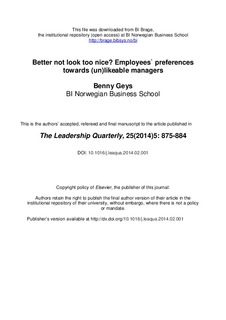Better Not Look Too Nice? Employees’ Preferences Towards (Un)Likeable Managers
| dc.contributor.author | Geys, Benny | |
| dc.date.accessioned | 2014-07-11T09:18:11Z | |
| dc.date.accessioned | 2014-10-06T11:09:16Z | |
| dc.date.available | 2014-07-11T09:18:11Z | |
| dc.date.available | 2014-10-06T11:09:16Z | |
| dc.date.issued | 2014 | |
| dc.identifier.citation | The Leadership Quarterly, 25(2014)5: 875-884 | nb_NO |
| dc.identifier.issn | 1048-9843 | |
| dc.identifier.issn | 1873-3409 | |
| dc.identifier.uri | http://hdl.handle.net/11250/223164 | |
| dc.description | This is the authors’ accepted, refereed and final manuscript to the article. Publisher’s version available at http://dx.doi.org/10.1016/j.leaqua.2014.02.001 | nb_NO |
| dc.description.abstract | Recent research shows that, all else equal, most people prefer likeable colleagues. In this article, two experiments are employed to analyze preferences with respect to (un)likeable ssuperiors. We thereby focus on perceptions of likeability based on appearance rather than as a behavioral characteristic, which allows us to concentrate on the impact of quick, unconscious evaluations in zero-acquaintance situations. The results indicate that, all else equal, managers of higher perceived likeability are less preferred than managers of lower perceived likeability. Such likeability-aversion emerges among male and female respondents, affects male and female managers, and holds both for preferences expressed from the perspective of employees (Experiment 1) or a HR department (Experiment 2). | nb_NO |
| dc.language.iso | eng | nb_NO |
| dc.publisher | Elsevier | nb_NO |
| dc.title | Better Not Look Too Nice? Employees’ Preferences Towards (Un)Likeable Managers | nb_NO |
| dc.type | Journal article | nb_NO |
| dc.type | Peer reviewed | nb_NO |
| dc.date.updated | 2014-07-11T09:18:12Z | |
| dc.source.journal | The Leadership Quarterly | nb_NO |
| dc.identifier.cristin | 1109466 | |
| dc.description.localcode | 2, Forfatterversjon | nb_NO |
Tilhørende fil(er)
Denne innførselen finnes i følgende samling(er)
-
Publikasjoner fra CRIStin - BI [1015]
-
Scientific articles [2173]
